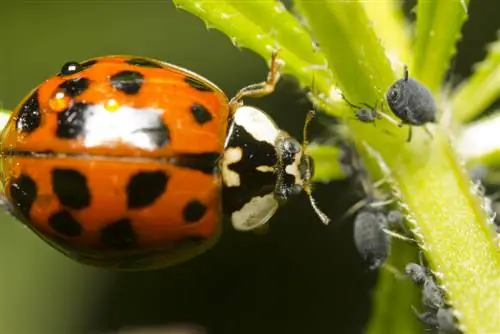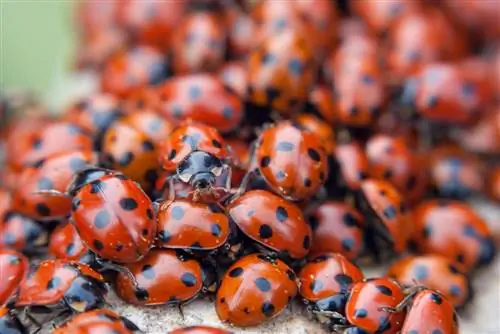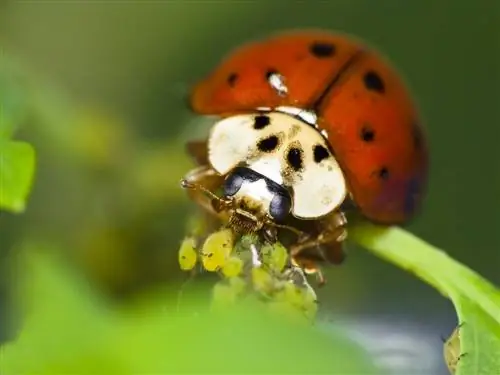- Author admin [email protected].
- Public 2023-12-16 16:46.
- Last modified 2025-01-23 11:22.
Ladybirds are called sky goats, sun calves or summer birds. Every child knows the spotted insects and knows that these crawling creatures eat aphids en masse. However, their menu is varied and is not limited to plant sap suckers.
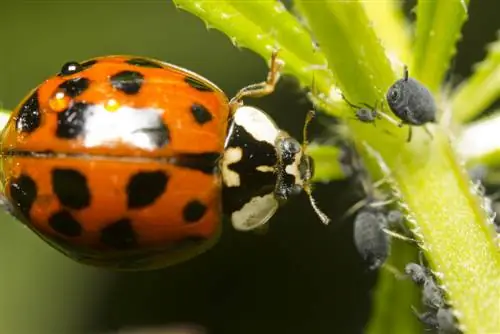
What do ladybugs like to eat most?
Ladybirds feed primarily on aphids and other plant sap suckers, but are able to diversify their diet depending on availability to include pollen, soft-shelled insects, eggs and larvae, and even plant material.
Species diversity in Germany
There are around 80 species of ladybirds in Germany. The insects love warmth, which is why they are mainly distributed in tropical and subtropical regions. The Asian lady beetle is an introduced species and makes life difficult for native representatives because of its voracity.
Common species and their coloring:
- Asian lady beetle: predominantly light yellow but also dark red to almost black
- Seven-spotted ladybird: red cover wings with a total of seven dark spots
- Two-spotted ladybug: black with red dots or red with black dots
Background
What coloring says about food
The two-spotted ladybird comes in two color variations. Depending on the color, the nutritional requirement changes, which is due to the connection between metabolic activity and body temperature. Black individuals warm up more when exposed to sunlight than red beetles.
The metabolism works faster at higher body temperatures. Therefore, these specimens have to eat more food in summer to avoid starvation. In winter, the black color proves to be a disadvantage because due to the high conversion rate, their fat reserves are used up more quickly. As a result, more red ladybugs survive than black ladybugs.
What do ladybugs eat?
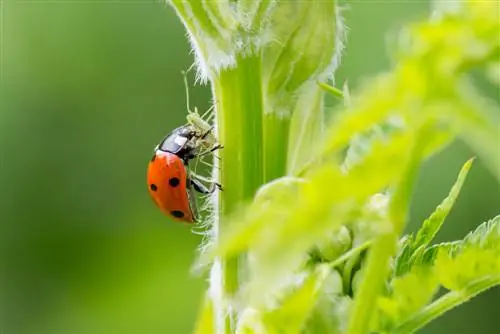
Ladybirds prefer to eat lice
The spotted insects are among the most effective pest controllers because their diet consists predominantly of plant sap-sucking lice. When food becomes scarce, larvae and adult beetles develop into cannibals. They then capture eggs and adults of their own species or from related individuals.
Wide range of foods:
- Bugs, spider mites and fringed beetles
- Larvae of beetles, sawflies and butterflies
- Leaves of crops such as potatoes or butterflies
- Mildew and mold fungi
- Fruits and pollen
Nutrition of native species
The preferred food of the common species differs minimally. First and foremost are aphids and fleas. The larvae of the Asian lady beetle eat around 1,000 insects in their lifetime, while the seven-spot lady beetle is somewhat less voracious. During its entire development, its offspring comes to around 400 captured plant sap suckers. Adult specimens of the multicolored ladybird eat 100 to 270 animals per day.
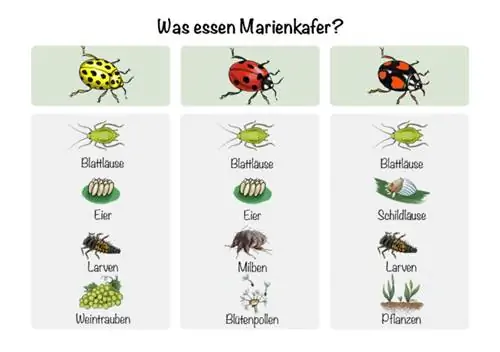
| what to eat | mainly | occasionally | rare |
|---|---|---|---|
| yellow ladybugs | Aphids | soft-shelled insects, eggs and larvae | Grapes |
| red ladybugs | Aphids and small species of mites | abandoned eggs | Bee pollen |
| black ladybugs | Aphids and scale insects | Larvae of other ladybirds | Plants |
Food options in autumn
The last warm days offer the ladybirds opportunities to replenish their fat reserves before the long winter. Therefore, if possible, leave wilted plants standing until next spring, because this is where the beetles look for food. Dead wood and rotten tree bark are also good sources of food. Various insects and larvae cavort between the wood fibers, looking for a place to overwinter.
Autumn menu:
- Aphids and spider mites as usual
- Bugs as alternative food
- Sawfly larvae and fringed beetles as a valuable addition
The two-spotted ladybird flies to the north in autumn because the temperatures here are constant during the winter months.
What do ladybugs eat in winter?
Ladybirds are cold-blooded insects that adapt their body temperature to the environment. This is necessary because the food supply is very limited during the cold season. During their hibernation, the beetles do not eat any food. They draw on fat reserves that they have built up in the warm months. If the crawlers wake up early from their resting phase, they cannot find enough food sources and often starve.

Tip
If you want to help native species over the winter, provide the insects with a wooden box lined with leaves and branches as a retreat. The animals dry out quickly during the cold season, which is why they retreat into protective cavities.
What do baby ladybugs eat?
The diet of the larvae does not differ from the preferences of adult beetles. Aphids and fleas as well as mildew and mold are also on their menu. If the adult insects feed on leaves of various plants or pollen, these food sources are not spurned by the offspring either. Based on eating habits, conclusions can be drawn about the typical habitats.
Where ladybugs live:
- on preferred plants such as carnations
- on flowering plants that produce a lot of pollen
- on ornamental and crop plants with aphid colonies or mold infestation
Food requirements of beetle larvae
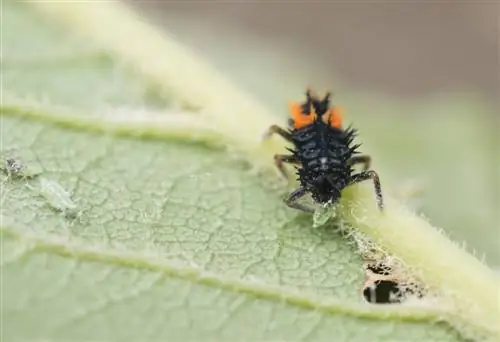
Ladybird larvae also love aphids
As the larvae develop, they become increasingly voracious. They eat most of the aphids in the last stage of development. If the ambient temperatures are high at this time, food conversion increases additionally.
Tip
To encourage ladybugs, you should ensure that your garden is designed in a natural way. On the balcony, clay pots filled with dead wood and rotten tree bark provide an ideal retreat with additional food. Numerous tiny creatures cavort in the wood.
Correlation between hunter and prey
Ladybird larvae react sensitively to the numerical changes in the aphid colonies. Their populations regulate themselves depending on the aphids present. If there were too many plant sap suckers in a season, the number of ladybirds increases. If there is not enough prey next year, the colonies of spotted insects will deplete again.
Frequently asked questions
What do ladybugs eat in the apartment?
Ladybirds often get lost in apartments through open windows and doors. The animals retreat to roof beams or cracks in facades to overwinter. This way they get indoors easily. If the insects appear en masse on the window pane during the winter months, their winter torpor has been disturbed by warmer temperatures.
However, you won't find enough food in houses, which is why you should take the crawlers outside again. If you want to help the beetles, put them in a wooden box with an entry hole filled with rotten wood, stems and leaves. Place the box in a cool place so that the ladybugs go back into hibernation.
What do ladybugs drink?
The small spotted insects have to replenish their fluid levels quickly, especially after the winter torpor, in order not to dry out. In nature, they drink water droplets that collect on the leaves. They cover part of their fluid needs by eating aphids.
You can help thirsty animals by using a pipette to place a small drop of water right next to the beetle. They don't mind if you liberally pollinate plants with a floral sprayer. Alternatively, you can also place moistened sponges, cloths or cotton balls in your self-made ladybug quarters.
What do Asian lady beetles eat besides aphids?
Harmonia axyridis is a good example of the high success rate in controlling pests. The species was introduced to Europe by humans to control massive aphid infestations in greenhouses. From here the multicolored ladybird was able to escape into nature, where it has since spread massively.
If no aphids are available, the beetles prey on soft-shelled insects and larvae. In times of need they feed on pollen. Eggs and adults of local ladybird larvae are also on the menu.
How do ladybugs overwinter?
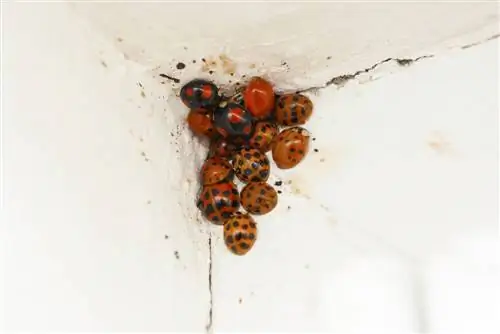
Ladybirds retreat to a warm place in winter
So that the beetles can survive the frosty winter, they retreat into protective niches. Conditions should be moist, frost-free and no warmer than eight degrees. Cracks in walls, niches under tree bark or cavities under moss offer ideal quarters for overwintering.
In the garden, insects like to retreat to piles of leaves or dead stems of perennials and grasses. It is not uncommon for them to crawl through openings in the house facade or settle in the rafters. When temperatures rise in winter, animals often gather in large numbers in houses and apartments.
Can I feed ladybugs in winter?
If the beetles wake up from their hibernation too early due to mild temperatures, the food supply is usually too low. If they are native species, you can increase the animals' chance of survival by feeding them additionally. Foods that contain sugar and are rich in vitamins are suitable.
Offer the beetles honey, sugar water, or syrup in a bottle cap. Dried fruits soaked in water such as raisins, apricots or figs are also ideal. Mild jam with a low acid content is also well received.
Important Notes:
- Beetles do not survive the winter in apartments
- sudden relocation from warm apartments to the winter cold ends in death
- Boxes filled with newspaper, wood chips and leaves are good temporary accommodation
- Crate should be placed in a frost-free room with openings to the outside
- Holes are used for ventilation and ensure the trip in spring

